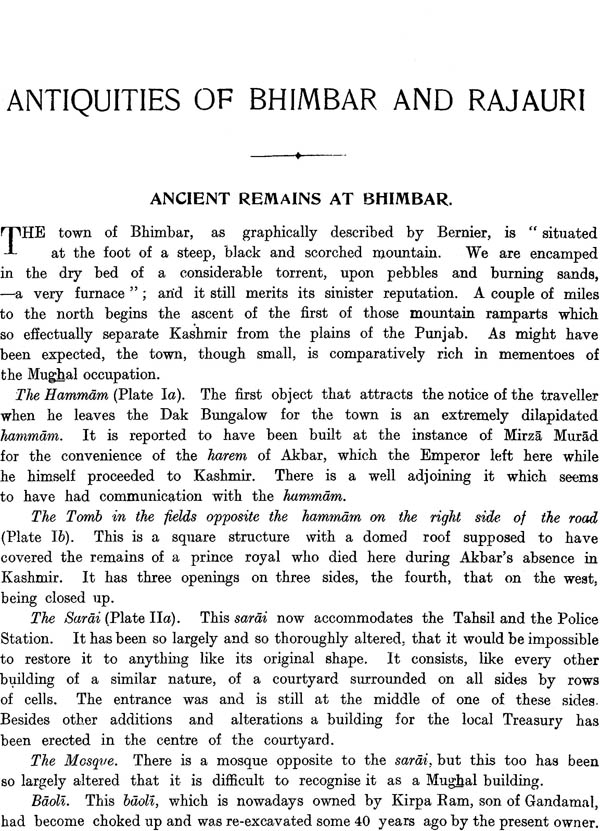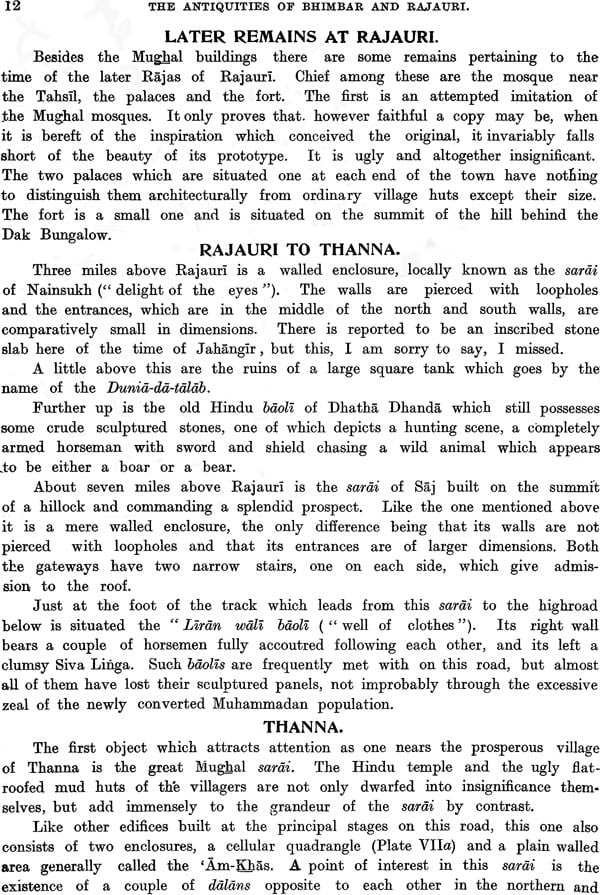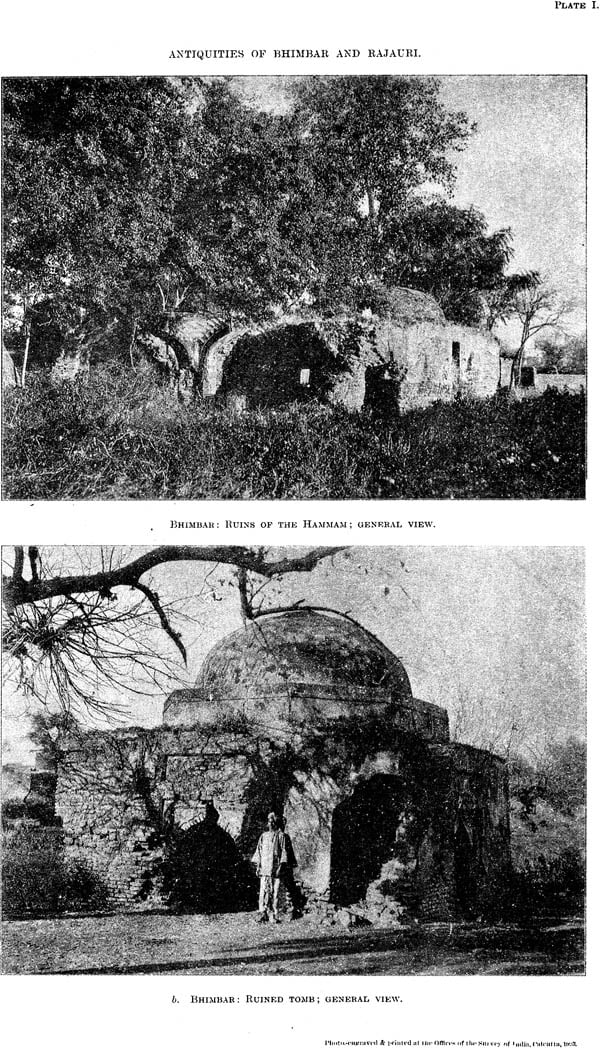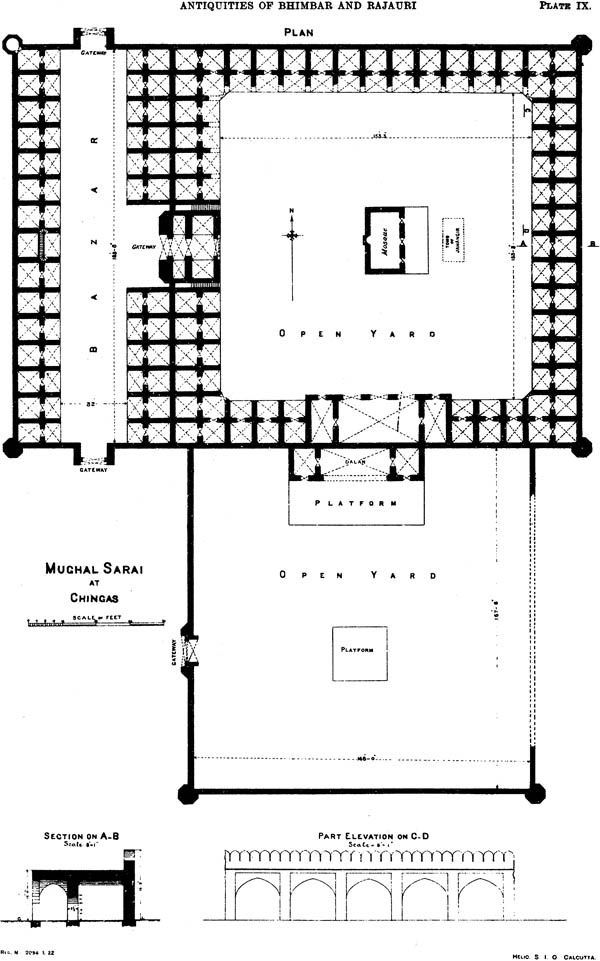
Antiquities of Bhimbar and Rajauri
Book Specification
| Item Code: | NAL919 |
| Author: | Ram Chandra Kak |
| Publisher: | Archaeological Survey of India |
| Language: | English |
| Edition: | 1998 |
| Pages: | 50 (12 Plates B/W Illustrations) |
| Cover: | Hardcover |
| Other Details | 10.5 inch X 8.5 inch |
| Weight | 350 gm |
Book Description
Preface
Bhimbar and Rajauri (which together formed part of the ancient territory of Darvabhisara) are two large Tahsils in the province of Jammu. The town of Bhimbar is situated only four or five miles from the British boundary and twenty-eight miles from Gujrat, which is the most convenient Railway Station for it, though the small flag station of Kharian is nearer. The word “convenient” is used in a strictly limited sense, for the road is mostly unmetalled and becomes in wet weather a regular quagmire. The absence of bridges, moreover, forces both horse and man to resort to the primitive method of wading across the streams. The journey is usually performed in seven hours, provided, of course, the lean and footsore ponies do not hopelessly break down in the middle of the road, or the roofless, ramshackle affair humourously called the “Mail Tonga” does not get inextricably stuck in the bed of a nallah.
The Bhimbar-Rajauri road, which, after crossing the Pir Pantsal at an altitude of 11,500 feet, debouches into the valley of Kashmir at the picturesque little town of Shupayan, is by far the shortest road to Srinagar from the Indian plains. It has from very ancient times played a prominent part in the political history of Kashmir. Mihirakula of infamous memory, after his defeat in India, retreated into Kashmir bythis route. But his misfortunes had not tamed his cruel disposition. One of this elephants accidentally fel down a precipice into the raging torrent below. On hearing the agonised cry of the unfortunate beast, the tyrant was so delighted that he immediately had a hundred other elephants driven headlong down the precipice to join the chorus. The place where this incident occurred is still known by the name of Hastivanz. Sure, the minister of Avantivarman, build the town Surapura (the modern Hurapora) to serve both as a frontier outpost and an emporium for trade. In Kalhana’s own time Pushyananada (the modern Pushyana) “served as a refuge for rebel leaders for whom Kashmir had become too hot.” Rajauri (the ancient Rajapuri) was the capital of the hill principatly of the same name, and its rulers were occasionally powerful enough to threaten the peace of Kashmir. Coming down to more recent time we find the road elevated to the dignity of an Imperial Mughal route, furnished with sumptuous rest-houses at every stage, and witnessing almost annually the splendid cavalcade of Jahan gir, Nur Jahan and the noble of the court, hurrying to escape the scorching heat and blinding dust-storms of the Punjab. And lastly, less than a hundred years ago, the present chapter of Kashmir history opened with the crossing of the valley of Kashmir, an attempt which was crowned with complete success.
For the traveler who possesses a fair knowledge of the ancient and modern history of Kashmir, the Pir. Pantsal route conjures up a host of departed memories and he feels
“Like one who treads alone
Some banquet hall deserted;
Whose light s are fled, whose garlands deas;
And al but he departed.”
| Preface | i-ii |
| Ancient Remains at Bhimbar | 1-2 |
| Saidabad | 2-4 |
| Saidabad to Naushera | 4-6 |
| Naushera | 6-7 |
| Naushera to Chings | 7-8 |
| Chings | 8-9 |
| Chings to Rajauri | 9 |
| Mughal Remains at Rajauri | 9-11 |
| Late Remains at Rajauri | 12 |
| Rajauri to Thanna | 12 |
| Thanna | 12-14 |
| Rajauri to Panjnara | 14 |
| Panjnara | 14-15 |
| Phere-da-Kot | 1 |
| Summary of Results | 15-16 |









